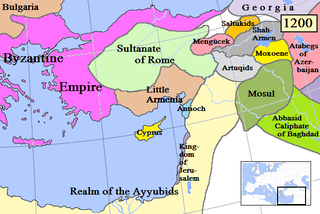Related Research Articles

Mu'izz ad-Din Muhammad, born Shihab ad-Din, also known as Muhammad of Ghor, was the Sultan of the Ghurid Empire along with his brother Ghiyath ad-Din Muhammad from 1173 to 1202 and as the sole ruler from 1202 to 1206. He is credited with laying the foundation of Muslim rule in the Indian subcontinent, which lasted for several centuries. He reigned over a territory spanning over parts of modern-day Afghanistan, Bangladesh, Iran, Northern India, Pakistan, Tajikistan and Turkmenistan.
Nasir al-Din, was originally a honorific title and is an Arabic masculine given name. There are many variant spellings in English.

The Artuqid dynasty was a Turkoman dynasty originated from Döğer tribe that ruled in eastern Anatolia, Northern Syria and Northern Iraq in the eleventh through thirteenth centuries. The Artuqid dynasty took its name from its founder, Artuk Bey, who was of the Döger branch of the Oghuz Turks and ruled one of the Turkmen beyliks of the Seljuk Empire. Artuk's sons and descendants ruled the three branches in the region: Sökmen's descendants ruled the region around Hasankeyf between 1102 and 1231; Ilghazi's branch ruled from Mardin and Mayyafariqin between 1106 and 1186 and Aleppo from 1117–1128; and the Harput line starting in 1112 under the Sökmen branch, and was independent between 1185 and 1233.

The Kart dynasty, also known as the Kartids, was a Sunni Muslim dynasty of Tajik origin closely related to the Ghurids, that ruled over a large part of Khorasan during the 13th and 14th centuries. Ruling from their capital at Herat and central Khorasan in the Bamyan, they were at first subordinates of Sultan Abul-Fateh Ghiyāṣ-ud-din Muhammad bin Sām, Sultan of the Ghurid Empire, of whom they were related, and then as vassal princes within the Mongol Empire. Upon the fragmentation of the Ilkhanate in 1335, Mu'izz-uddin Husayn ibn Ghiyath-uddin worked to expand his principality. The death of Husayn b. Ghiyath-uddin in 1370 and the invasion of Timur in 1381, ended the Kart dynasty's ambitions.

Rukn al-Din Abu'l-Muzaffar Berkyaruq ibn Malikshah, better known as Berkyaruq (برکیارق), was the fifth sultan of the Seljuk Empire from 1094 to 1105.
Shams al-Din 'Ali ibn Mas'ud ibn Khalaf ibn Mihraban was the first Mihrabanid malik of Sistan. He ruled from 1236 until his death.
Qutb al-Din Muhammad was the Mihrabanid malik of Sistan from 1330 until his death. He was the son of Rukn al-Din Mahmud.
Taj al-Din was the Mihrabanid malik of Sistan from 1346 until 1350. He was the son of Qutb al-Din Muhammad.
Izz al-Din was the Mihrabanid malik of Sistan from 1352 until 1380. He was the son of Rukn al-Din Mahmud.
Qutb al-Din was the Mihrabanid malik of Sistan from 1380 until 1383. He was the son of Izz al-Din ibn Rukn al-Din Mahmud.

The Mihrabanid dynasty was a Muslim dynasty that ruled Sistan from 1236 until the mid-16th century. It was the third indigenous Muslim dynasty of Sistan, having been preceded by the Saffarid and Nasrid dynasties.
Taj al-Din Shah-i Shahan Abu'l Fath or Shah-i-Shahan of Sistan was the Mihrabanid malik of Sistan from 1383 until his death. He was the son of Mas'ud Shihna.
Nasir al-Din Muhammad was the Mihrabanid malik of Sistan from 1261 until his death. He was the son of Mubariz al-Din Abu'l-Fath ibn Mas'ud.
Shams al-Din 'Ali was the Mihrabanid malik of Sistan from 1419 until his death. He was the son of Qutb al-Din Muhammad.
Shams al-Din Muhammad was the Mihrabanid malik of Sistan from 1480 until around the end of the 15th century. He was the eldest son of Nizam al-Din Yahya.

The Hazaraspids, was a Kurdish dynasty that ruled the Zagros Mountains region of southwestern Iran, essentially in Lorestan and which flourished in the later Saljuq, Ilkhanid, Muzaffarid, and Timurid periods.
Sultan Mahmud was the last Mihrabanid malik of Sistan, from c. 1495 until c. 1537.

Ghiyath al-Din Muhammad, also known as Ghiyath al-Din Ghori, was the sultan of the Ghurid dynasty from 1163 to 1202. During his reign, the Ghurid dynasty became a world power, which stretched from Gorgan to Bengal.
Sayf ad-Din Tankiz ibn Abdullah al-Husami an-Nasiri better known simply as Tankiz was the Damascus-based Turkic na'ib al-saltana (viceroy) of Syria from 1312 to 1340 during the reign of the Bahri Mamluk sultan an-Nasir Muhammad.
Asad al-Dīn Rumaythah ibn Muḥammad Abī Numayy al-Ḥasanī was Emir of Mecca seven times between 1301 and 1345.
References
- Bosworth, C.E. The History of the Saffarids of Sistan and the Maliks of Nimruz (247/861 to 949/1542-3). Costa Mesa, California: Mazda Publishers, 1994.